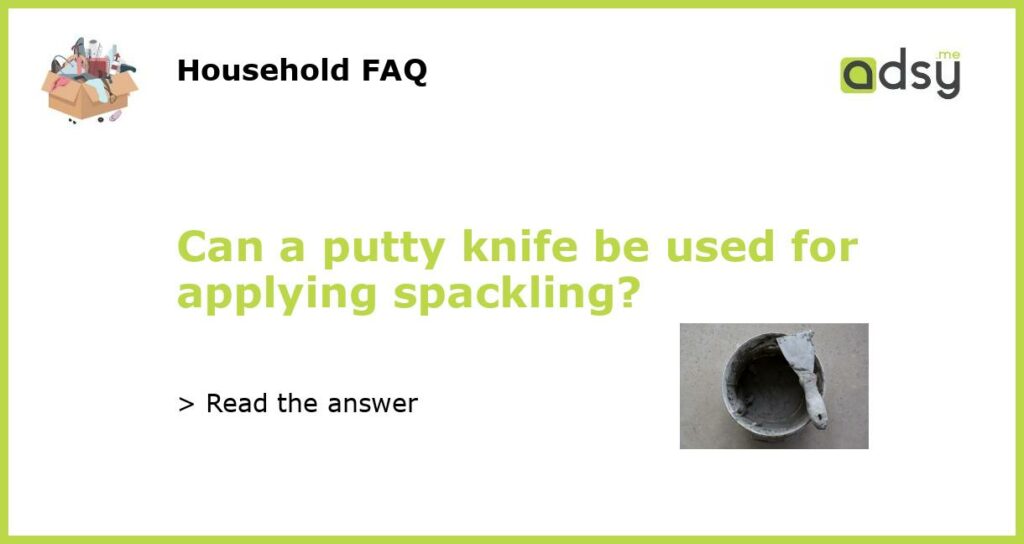Yes, a Putty Knife can be used for Applying Spackling
A putty knife is a versatile tool that is commonly used for spreading and smoothing compounds such as putty, spackle, and plaster. While putty knives are primarily known for their use in filling small holes and cracks, they can also be used for applying spackling. In this article, we will discuss how to use a putty knife for applying spackling and highlight some of the benefits of using this tool.
What is Spackling?
Spackling is a type of lightweight compound that is used to fill small holes, cracks, and imperfections in walls, ceilings, and other surfaces. It is commonly used in the process of repairing damaged drywall or plaster. Spackling is typically made from a mixture of gypsum or calcium carbonate, along with adhesive and water. It is available in a variety of forms, including pre-mixed tubs or as a powder that can be mixed with water.
How to Use a Putty Knife for Applying Spackling
Using a putty knife for applying spackling is a straightforward process that requires a few basic steps. Here’s a step-by-step guide:
Step 1: Prep the Surface
Before applying spackling, it is important to prep the surface to ensure proper adhesion. Start by cleaning the area with a damp cloth or sponge to remove any dirt, dust, or debris. If the surface has loose or flaking paint, gently scrape it away with a putty knife or sandpaper. Make sure the surface is dry before moving on to the next step.
Step 2: Load the Putty Knife
To load the putty knife, scoop up a small amount of spackling compound with the edge of the knife. The amount of spackle you need will depend on the size of the area you are repairing. Start with a small amount, as you can always add more if needed.
Step 3: Apply the Spackling
Hold the putty knife at a slight angle and use the edge of the knife to spread the spackling compound over the damaged area. Apply firm, even pressure to ensure that the spackle fills the hole or crack completely. If necessary, use the knife to feather out the edges of the spackling to create a smooth finish.
Step 4: Remove Excess Spackling
After applying the spackling, use the flat side of the putty knife to scrape off any excess compound. Hold the knife at a low angle to the surface and use long, smooth strokes to remove the excess spackling. Be careful not to remove too much spackle, as this can result in a depression in the repaired area. Allow the spackle to dry completely before moving on to the next step.
Step 5: Sand and Finish
Once the spackling has dried, use sandpaper or a sanding sponge to smooth out the repaired area. Start with a coarse-grit sandpaper and gradually move to a finer-grit sandpaper for a smoother finish. Sand in a circular motion, blending the repaired area with the surrounding surface. Wipe away any dust with a damp cloth or sponge. If necessary, apply a coat of primer and paint to match the surrounding surface.
Benefits of Using a Putty Knife for Applying Spackling
Using a putty knife for applying spackling offers several benefits:
1. Versatility: Putty knives are designed to be versatile and can be used for a variety of tasks, including applying spackling. This makes them a handy tool to have in your toolbox.
2. Control: Putty knives are typically available in a variety of sizes, allowing you to choose the right one for the job. The flat, flexible blade of a putty knife gives you control and precision when applying spackling.
3. Cost-effective: Putty knives are relatively inexpensive compared to other specialty tools. They are a cost-effective option for DIYers or professionals who need a tool for occasional use.
4. Easy to clean: Putty knives are easy to clean, requiring only soap and water. After using a putty knife for applying spackling, simply wash it with warm, soapy water and dry it thoroughly. This will help maintain the quality and longevity of the tool.
Conclusion
In conclusion, a putty knife can be used for applying spackling. It is a versatile tool that offers control, precision, and ease of use. By following the steps outlined in this article, you can effectively use a putty knife to apply spackling and achieve a smooth, professional finish.






